
An engine or motor is a machine designed to convert one form of energy into mechanical energy. Heat engines, like the internal combustion engine, burn a fuel to create heat which is then used to do work. Electric motors convert electrical energy into mechanical motion, pneumatic motors use compressed air, and clockwork motors in wind-up toys use elastic energy. In biological systems, molecular motors, like myosins in muscles, use chemical energy to create forces and eventually motion.

George Westinghouse Jr. was an American entrepreneur and engineer based in Pennsylvania who invented the railway air brake and was a pioneer of the electrical industry, gaining his first patent at the age of 19. Westinghouse saw the potential in alternating current as an electricity distribution system in the early 1880s and put all his resources into developing and marketing it, a move that put his business in direct competition with the Edison direct current system. In 1911 Westinghouse received the AIEE's Edison Medal "For meritorious achievement in connection with the development of the alternating current system."
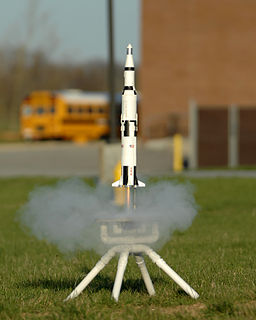
A model rocket is a small rocket designed to reach low altitudes and be recovered by a variety of means.
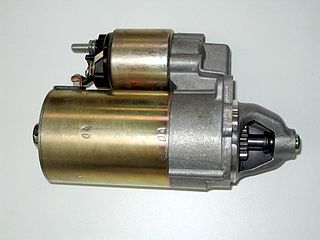
A starter is a device used to rotate (crank) an internal-combustion engine so as to initiate the engine's operation under its own power. Starters can be electric, pneumatic, or hydraulic. In the case of very large engines, the starter can even be another internal-combustion engine.

A rocket engine uses stored rocket propellant mass for forming its high-speed propulsive jet. Rocket engines are reaction engines, obtaining thrust in accordance with Newton's third law. Most rocket engines use combustion, although non-combusting forms also exist. Vehicles propelled by rocket engines are commonly called rockets. Since they need no external material to form their jet, rocket engines can perform in a vacuum and thus can be used to propel spacecraft and ballistic missiles.

A rack and pinion is a type of linear actuator that comprises a circular gear engaging a linear gear, which operate to translate rotational motion into linear motion. Driving the pinion into rotation causes the rack to be driven linearly. Driving the rack linearly will cause the pinion to be driven into a rotation.

A windscreen wiper or windshield wiper is a device used to remove rain, snow, ice and debris from a vehicle's front window. Almost all motor vehicles, including cars, trucks, buses, train locomotives, and watercraft with a cabin—and some aircraft—are equipped with one or more such wipers, which are usually a legal requirement.

The Brayton cycle is a thermodynamic cycle named after George Brayton that describes the workings of a constant-pressure heat engine. The original Brayton engines used a piston compressor and piston expander, but more modern gas turbine engines and airbreathing jet engines also follow the Brayton cycle. Although the cycle is usually run as an open system, it is conventionally assumed for the purposes of thermodynamic analysis that the exhaust gases are reused in the intake, enabling analysis as a closed system.
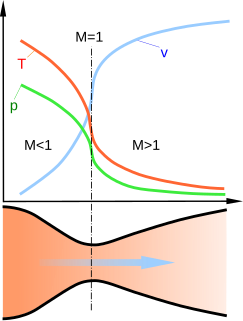
A de Laval nozzle is a tube that is pinched in the middle, making a carefully balanced, asymmetric hourglass shape. It is used to accelerate a hot, pressurized gas passing through it to a higher supersonic speed in the axial (thrust) direction, by converting the heat energy of the flow into kinetic energy. Because of this, the nozzle is widely used in some types of steam turbines and rocket engine nozzles. It also sees use in supersonic jet engines.

A liquid-propellant rocket or liquid rocket is a rocket engine that uses liquid propellants. Liquids are desirable because their reasonably high density allows the volume of the propellant tanks to be relatively low, and it is possible to use lightweight centrifugal turbopumps to pump the propellant from the tanks into the combustion chamber, which means that the propellants can be kept under low pressure. This permits the use of low-mass propellant tanks, resulting in a high mass ratio for the rocket.
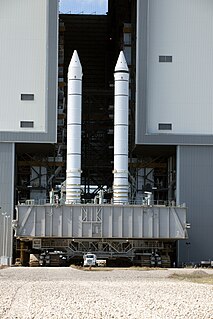
The Space Shuttle Solid Rocket Boosters (SRBs) were the first solid-propellant rocket to be used for primary propulsion on a vehicle used for human spaceflight and provided the majority of the Space Shuttle's thrust during the first two minutes of flight. After burnout, they were jettisoned and parachuted into the Atlantic Ocean where they were recovered, examined, refurbished, and reused.
Electromagnetic propulsion (EMP), is the principle of accelerating an object by the utilization of a flowing electrical current and magnetic fields. The electrical current is used to either create an opposing magnetic field, or to charge a field, which can then be repelled. When a current flows through a conductor in a magnetic field, an electromagnetic force known as a Lorentz force, pushes the conductor in a direction perpendicular to the conductor and the magnetic field. This repulsing force is what causes propulsion in a system designed to take advantage of the phenomenon. The term electromagnetic propulsion (EMP) can be described by its individual components: electromagnetic – using electricity to create a magnetic field, and propulsion – the process of propelling something. When a fluid is employed as the moving conductor, the propulsion may be termed magnetohydrodynamic drive. One key difference between EMP and propulsion achieved by electric motors is that the electrical energy used for EMP is not used to produce rotational energy for motion; though both use magnetic fields and a flowing electrical current.
Direct impingement is a type of gas operation for a firearm that directs gas from a fired cartridge directly into the bolt carrier or slide assembly to cycle the action.

The M72 LAW is a portable one-shot 66-mm unguided anti-tank weapon. The solid rocket propulsion unit was developed in the newly formed Rohm and Haas research laboratory at Redstone Arsenal in 1959, then the full system was designed by Paul V. Choate, Charles B. Weeks, Frank A. Spinale, et al. at the Hesse-Eastern Division of Norris Thermadore. American production of the weapon began by Hesse-Eastern in 1963, and was terminated by 1983; currently it is produced by Nammo Raufoss AS in Norway and their subsidiary Nammo Talley, Inc. in Arizona.
Vapor-compression refrigeration or vapor-compression refrigeration system (VCRS), in which the refrigerant undergoes phase changes, is one of the many refrigeration cycles and is the most widely used method for air-conditioning of buildings and automobiles. It is also used in domestic and commercial refrigerators, large-scale warehouses for chilled or frozen storage of foods and meats, refrigerated trucks and railroad cars, and a host of other commercial and industrial services. Oil refineries, petrochemical and chemical processing plants, and natural gas processing plants are among the many types of industrial plants that often utilize large vapor-compression refrigeration systems.
A search aggregator is a type of metasearch engine which gathers results from multiple search engines simultaneously, typically through RSS search results. It combines user specified search feeds to give the user the same level of control over content as a general aggregator.

A snap gun, also known as lock pick gun, pick gun, or electric lock pick, is a tool that can be used to open a mechanical pin tumbler lock without using the key. A steel rod is inserted into the lock and the snap gun briefly fires the rod against all of the lock pins simultaneously, momentarily freeing the cylinder and enabling it to be turned using a tension wrench. The snap gun is an alternative to a conventional lockpick, which requires other techniques such as raking to free the pins.

Unit injector (UI) is an high pressure integrated direct fuel injection system for diesel engines, combining the injector nozzle and the injection pump in a single component. The plunger pump used is usually driven by a shared camshaft. In a unit injector, the device is usually lubricated and cooled by the fuel itself.
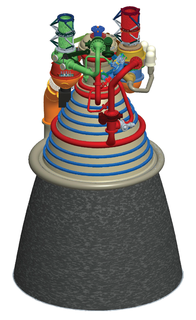
Nozzle extension — nozzle expander of reaction/rocket engine. The application of nozzle extensions improves efficiency of rocket engines in vacuum by increasing nozzle expansion ratio. As a rule, their modern design assumes use of carbon-carbon materials without regenerative cooling. Along with sliding expanders, stationary nozzle extensions have some applications too.
















